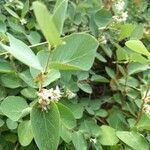A small plant. It grows 25-100 cm high. It has creeping roots. The leaves are opposite and simple. They are oval or oblong and have a short leaf stalk. They are thick and leathery. They are 2.5-8 cm long. They have soft hairs underneath. The flowers are pinkish-white and small. They are 6 cm long. Several flowers occur together in clusters in the axils of the leaves. The fruit are a dull greenish-white berry.

